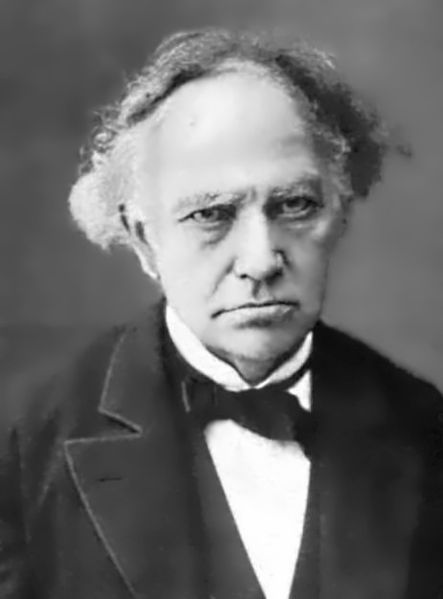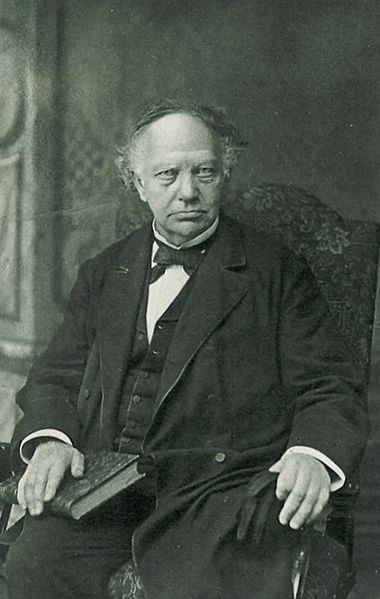<Back to Index>
- Mathematician Charles Hermite, 1822
- Painter Wilhelm Nikolaj Marstrand, 1810
- 11th President of Finland Tarja Kaarina Halonen, 1943
PAGE SPONSOR


Charles Hermite (December 24, 1822 – January 14, 1901) was a French mathematician who did research on number theory, quadratic forms, invariant theory, orthogonal polynomials, elliptic functions, and algebra.
Hermite polynomials, Hermite interpolation, Hermite normal form, Hermitian operators, and cubic Hermite splines are named in his honor. One of his students was Henri Poincaré. He was the first to prove that e, the base of natural logarithms, is a transcendental number. His methods were later used by Ferdinand von Lindemann to prove that π is transcendental. In a letter to Thomas Stieltjes in 1893, Hermite famously remarked: "I turn with terror and horror from this lamentable scourge of continuous functions with no derivatives." Born at Dieuze, Moselle,
24 December, 1822 he was the son of a salt mine engineer, Ferdinand
Hermite. His mother was Madeleine Lallemand. The family moved to run a
drapers business in Nancy in 1828 and his father also pursued ambitions
as an artist. Charles was the sixth of his parents' seven children.
Charles had a defect in his right foot which meant that from boyhood he
moved around with difficulty. He studied at the Collège de Nancy and then, in Paris, at the Collège Henri IV and at the Collège Louis-le-Grand. Hermite wanted to study at the École Polytechnique and he took a year preparing for the examinations and was tutored by Catalan between 1841 and 1842. In 1842 he entered the École Polytechnique,
where he remained as a student for a short time. After one year at the
École Polytechnique Hermite was refused the right to continue
his studies because of his disability. He had to fight to regain his
place which he won but with strict conditions imposed. Hermite found
this unacceptable and decided to leave the École Polytechnique without graduating. As a boy he read some of the writings of Joseph Louis Lagrange on the solution of numerical equations, and of Carl Gauss on
the theory of numbers. In 1842, his first original contribution to
mathematics, in which he gave a simple proof of the proposition of Niels Abel concerning
the impossibility of obtaining an algebraic solution for the equation
of the fifth degree, was published in the "Nouvelles Annales de
Mathématiques". A correspondence with Carl Jacobi,
begun in 1843 and continued in 1844, led to the insertion, in the
complete edition of Jacobi's works, of two articles by Hermite, one
concerning the extension to Abelian functions of one of the theorems of Abel on elliptic functions, and the other concerning the transformation of elliptic functions. After spending five years working privately towards his degree, in which he befriended eminent mathematicians Joseph Bertrand, Carl Gustav Jacob Jacobi, and Joseph Liouville, he took and passed the examinations for the baccalauréat, which he was awarded in 1847. He married Joseph Bertrand's sister, Louise Bertrand in 1848. In
1848, Hermite returned to the École Polytechnique as
répétiteur and examinateur d'admission. In 1856 he
contracted smallpox. Through the influence of Augustin Cauchy and
of a nun who nursed him, he resumed the practice of his religion. On 14
July, of that year, he was elected to fill the vacancy created by the
death of Jacques Binet in the Académie des Sciences. In 1869, he succeeded Jean-Marie Duhamel as
professor of mathematics, both at the École Polytechnique, where
he remained until 1876, and in the Faculty of Sciences of Paris, which
position he occupied until his death. From 1862 to 1873 he was lecturer at the École Normale Supérieure.
Upon his seventieth birthday, on the occasion of his jubilee which was
celebrated at the Sorbonne under the auspices of an international
committee, he was promoted grand officer of the Légion d'honneur. He died in Paris, 14 January, 1901, aged 78.
As a teacher Hermite was inspiring. His correspondence with Thomas Stieltjes testifies
to the great aid he gave those entering scientific life. His efforts in
teaching were directed not towards too rigorous minuteness, but towards
exciting admiration for things simple and beautiful. His published
courses of lectures have exercised a wide influence. His important
original contributions to pure mathematics, published in the leading mathematical journals of the world, dealt chiefly with Abelian and elliptic functions and the theory of numbers. In 1858 he solved the equation of the fifth degree by elliptic functions; and in 1873 he proved e, the base of the natural system of logarithms, to be transcendental. This last was used by Ferdinand von Lindemann to prove in 1882 the same for π.